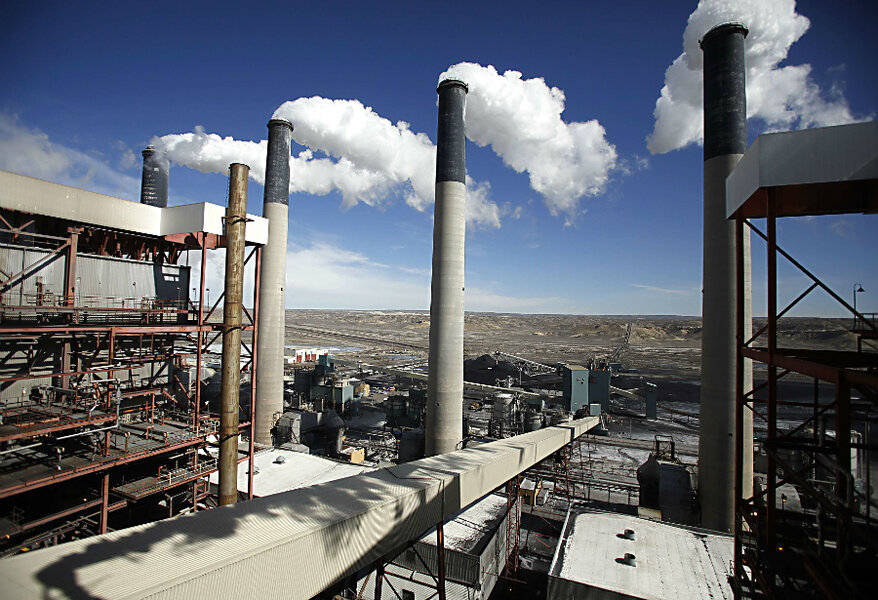Hopeful combo: World economy grows, carbon emissions stay flat
Loading...
| Paris
There’s good news from the climate change front. Hurrah!
Don’t throw your hats too high in the air, warn the experts. The world is still a very long way from doing everything it needs to do to get global warming under control.
But for the third year in a row, global energy-related carbon dioxide emissions were flat in 2016, in what the International Energy Agency (IEA) says is beginning to look like a trend.
And construction of coal-fired power plants – the villains of the CO2 story – slumped last year, according to a report by a group of environmental organizations. New starts dropped by 62 percent.
That puts the goal that the world has set itself, of holding temperature rises to less than 2 degrees C above preindustrial levels, “within feasible reach,” says the new report by Greenpeace, the Sierra Club, and CoalSwarm.
But there are few grounds for complacency. No sooner had the IEA trumpeted its latest findings on CO2 emissions last week than it came up with a new study warning that meeting the 2 degree target will take “an energy transition of exceptional depth, scope and speed” unlike anything we have ever seen.
Flattening energy-related emissions (which make up two-thirds of all human-generated greenhouse gases) is “very, very good news,” says Laura Cozzi, an IEA official, because they have leveled out even as the world economy grew by 3.1 percent.
Historically, emissions have tracked economic performance, dropping only during recessions. If the only way to reduce CO2 emissions was to sacrifice economic growth, it would be politically impossible, especially with 1.3 billion people living below the poverty line, most without electricity.
So the new IEA figures are “very encouraging,” says Robert Gross, a climate change expert at Imperial College, London, and a former British government adviser. “They demonstrate that economic growth and carbon emissions can be decoupled.”
The United States and China saw the biggest fall in their energy-related CO2 emissions last year. In America that was largely because a surge in shale gas supplies displaced coal, although ever cheaper renewable resources and greater energy efficiency also played a role.
In fact, a diverse group of about 30 countries, ranging from the US to Uzbekistan and from Portugal to Ukraine have seen their economies grow and their CO2 emissions fall for several years, says Nate Aden, a researcher with the World Resources Institute, an environmental watchdog.
It is too soon to say that greenhouse gas emissions have peaked, though, and even if they had, that achievement would fall well short of the cuts in emissions needed to stay below the 2 degree ceiling.
Just how far short is starkly evident from a second IEA report published on Monday, which found that energy-related CO2 emissions, which include things like transportation fuels as well as power plants, would have to fall by over 70 percent by 2050.
That would mean that by mid-century nearly all the electricity in the world would need to be generated from low-carbon sources; that 7 in 10 new cars would need to be electric (up from 1 in 100 today); that the entire building stock would have to be retrofitted for efficiency; and industry would need to emit 80 percent less CO2 per unit of output.
A recent study by the Energy Innovation Reform Project found that emissions from the power generation sector would have to fall to near zero.
That is perhaps not as utopian as it sounds. For one thing, consider recent trends in the coal-fired power plant business.
This week’s report by Greenpeace and other organizations found record levels of plant retirement in the US and Europe. But what really made the difference was a dramatic fall in the number of new plants starting in India and China. Those two countries built 86 percent of the world’s coal-fired power stations over the past decade.
In China, the government’s campaign to curb air pollution, among other things, has led to strict controls and an 85 percent drop in the number of permits for coal-fired power plants last year. In India, the government warned last December that there is so much surplus capacity in the sector that no new coal-fired plants will be needed for another 10 years.
“That makes it very hard to secure financing because banks do not believe new plants would run enough to make profits,” says Lauri Myllyvirta, one of the report’s authors.
At the same time, he adds, renewable energy sources are becoming economically competitive in India. In China, all the increase in power demand since 2013 has been met from nonfossil resources.
They are not always the greenest of resources. Indeed, wind and solar power make a relatively small contribution. Fifty percent of the new electricity comes from hydropower, generated by dams that often do irreparable environmental damage, and 25 percent of it comes from nuclear energy, long a bugbear for environmentalists.
Indeed, some energy experts argue that more nuclear plants – ones touted as being more advanced and safer than in the past – alongside solar and wind, will be needed if midcentury ambitions on carbon reduction are to be met.
And a good deal of the credit for the fact that global CO2 emissions are steady goes to shale gas, which is a fossil fuel.
But in the face of an emergency, ideals may have to be set aside. “Gas has half the emissions of coal, therefore it is half as damaging to burn gas as it is to burn coal. Period,” says Dr. Gross.
In the end, asks Martin Beniston, chairman for climate research at the University of Geneva, Switzerland, “what can we do? “We have to supply energy and comfort to people who have a right to it, especially in the developing countries. We just have to limit the impact on the environment as much as we can.”








